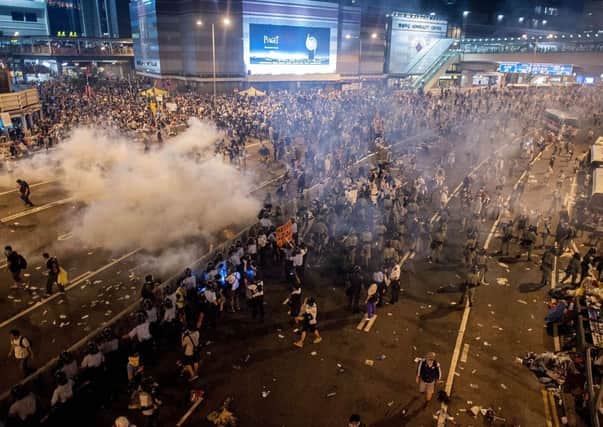Hong Kong protest met with tear gas


After spending hours holding the protesters at bay, police lobbed canisters of tear gas into the crowd last night, which scattered, but later reassembled.
However, last night a Hong Kong student group issued a statement on its Facebook page urging supporters to withdraw from protests in the heart of the city. The Hong Kong Federation of Students said it feared that police would use rubber bullets to disperse the crowd.
Advertisement
Hide AdAdvertisement
Hide AdStudents and activists have been camped out on the streets outside the government complex since Friday evening. By yesterday morning, leaders of the broader Occupy Central civil disobedience movement said they were joining them, to kick-start a long-threatened mass sit-in to demand that an election for Hong Kong’s leader be held without Beijing’s interference.
Police used the tear gas after the protest spiralled into an extraordinary scene of chaos, with the demonstrators jamming a busy road and clashing with officers wielding pepper spray.
The protesters were trying to reach a mass sit-in being held outside government headquarters to demand Beijing grant genuine democratic reforms to the former British colony.
“It was very cruel for the police to use such harsh violence on protesters who had been completely peaceful,” said one of the demonstrators, Cecily Lui, a 30-year-old clerk. “They were just sitting down on the road asking to speak with [Hong Kong leader] Leung Chun-ying to start a dialogue. Now, police have solved nothing and students are more resolved to stay.”
After using the tear gas, police issued a statement urging the protesters to leave peacefully, “otherwise police will use a higher level of force in order to restore public order and safeguard public safety.”
The demonstrations – which Beijing called “illegal” – were a rare scene of disorder in the Asian financial hub, and highlighted the authorities’ inability to rein in the public discontent over Beijing’s tightening grip on the city. The protesters rejected Beijing’s decision last month to rule out open nominations for candidates under proposed guidelines for the first-ever elections for Hong Kong’s leader, promised for 2017.
China took control of the former British colony in 1997, agreeing to a policy of “one country, two systems” that allowed Hong Kong to keep civil liberties unseen on the mainland, while promising that the city’s leader could eventually be chosen through “universal suffrage.” But Beijing’s insistence on screening election candidates for patriotism to China has stoked fears among democracy groups that Hong Kong will never get genuine democracy.
The thousands of protesters who tried to join the sit-in breached a police cordon, spilling out onto a busy highway and causing traffic to come to a standstill. Police officers in a buffer zone manned barricades and used pepper spray on protesters. The demonstrators, who tried at one point to pull down metal barricades, carried umbrellas to deflect the spray by the police.
Advertisement
Hide AdAdvertisement
Hide AdAfter police used the tear gas, the protesters chanted “Shame on C Y Leung,” referring to the city’s deeply unpopular Beijing-backed leader. To many, it seemed to mark a major shift for Hong Kong, whose residents have long felt their city stood apart from mainland China thanks to its guaranteed civil liberties and separate legal and financial systems.
Earlier, police said they had arrested 78 people since demonstrations started though all but three were released.
Mr Leung said Hong Kong’s government was “resolute in opposing the unlawful occupation” of the government offices or the financial district by Occupy Central.